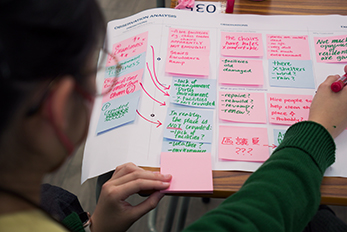WHAT is it?
The word ‘empathy’ originally had an aesthetic meaning. It first appeared in the early 1900s as a translation of the German Einfühlung (‘in- feeling’), drawing on the Greek ‘em’ for ‘in’ and ‘pathos’ for ‘feeling’. This early empathy was not about understanding another person but about projecting one’s own imagined feelings and movements into objects. Empathy was seen as key to the pleasures of art.
It was only in the 1930s that American psychologists extended its meaning to the ability to understand another person.
WHY teach it?
What if things could talk? What would they say?
Who would they want to talk to? The talking bubble sticker set lets students imagine tangible artefacts from different perspectives. The sticker set comes with guiding question stickers and blank stickers, guiding students to imagine figuratively how things fit into different relationship networks of things and people.

HOW to do it?
▸ Introduction (10mins)
Explain the goal of the day and the several steps that the students will go through.
▸ Talking Stickers (40mins)
At the stage of having identified artefacts related to the projects, ask the students for photos or drawings of these artefacts.
Ask them to choose different stickers and try to imagine what the artefacts would ‘say’ according to the guiding text


















